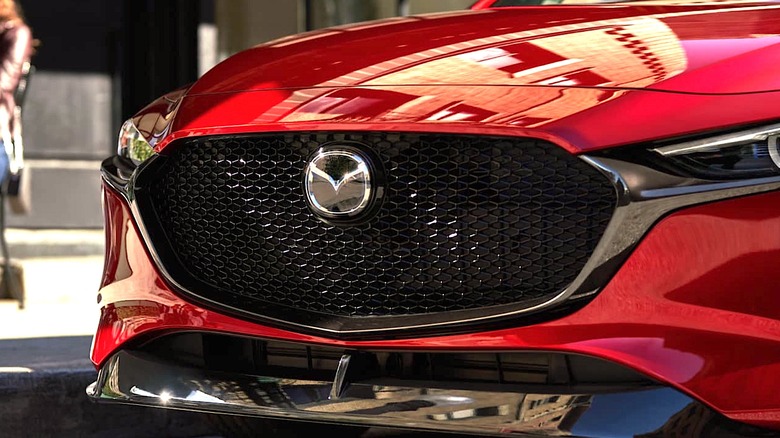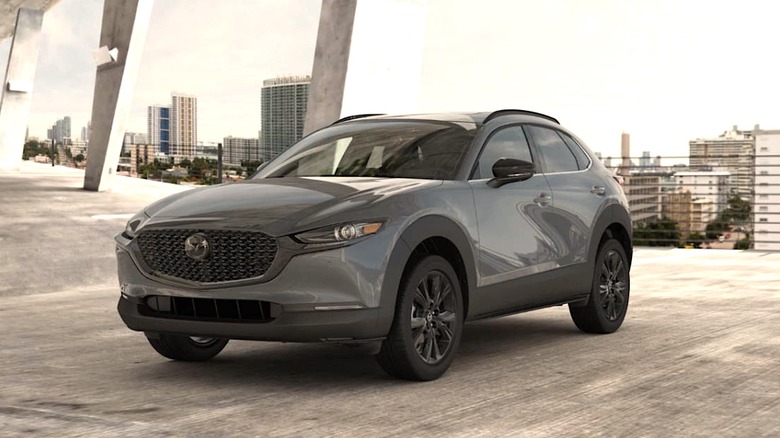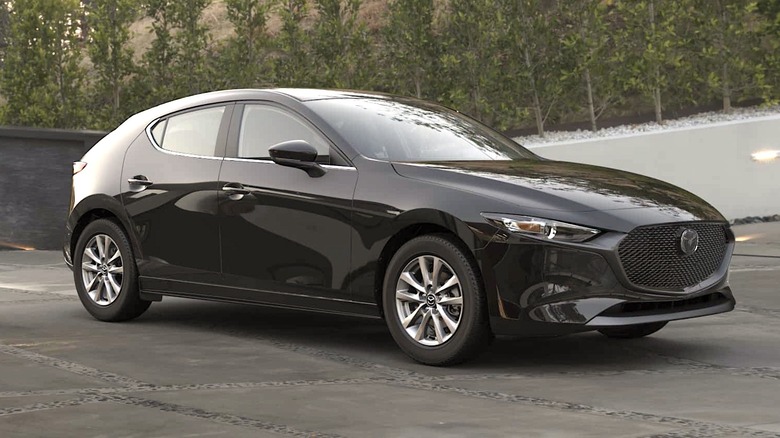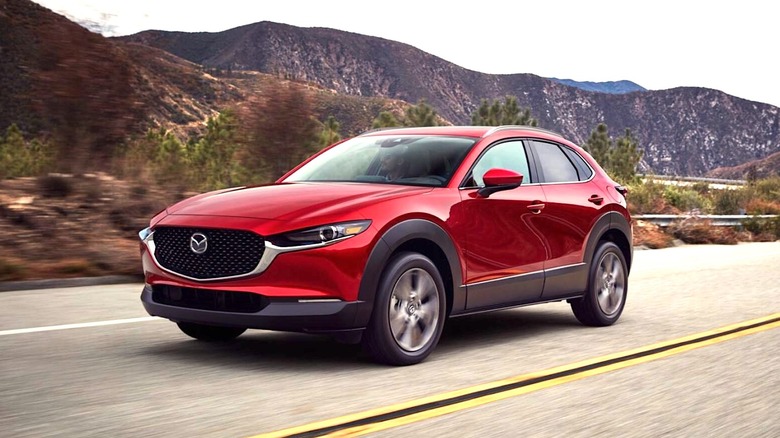Mazda CX-30 Vs Mazda3 Hatchback: 3 Important Differences To Know Before You Buy
In the century since its humble beginnings as a cork manufacturer, Mazda has become one of the best-selling auto brands in the United States. The Japanese automaker has achieved that status in part by focusing on the manufacture of smaller, dependable automobiles, fronting solid fuel economy and performance. Focusing on those vital factors has helped Mazda develop a line of vehicles as celebrated for their reliability as they are for their prowess on the road.
Among the more revered makes in the manufacturer's stable of cars and SUVs are sleek hatchback builds like the CX-30 and the Mazda3. The latter vehicle has, of course, been a part of the Mazda lineup since the early 2000s and, during its two decades of production, has regularly ranked among the automaker's best-selling cars. The former, however, is a relatively new addition to the Mazda stable, with CX-30s first hitting the streets of North America in 2020.
In recent years, builds of both the Mazda3 and the CX-30 have each earned the SlashGear seal of approval. While the largely positive reviews might be enough to put the vehicles in the new car purchase conversation for some of our faithful readers, you still might have difficulty deciding exactly which build best suits your needs. That's because the Mazda3 and the CX-30 deliver distinctly different driving experiences — even as they boast several striking similarities.
Size matters between the CX-30 and Mazda3
If you've had occasion to visit a Mazda showroom to check out the CX-30 or Mazda3 of late, you no doubt noticed the one major difference between the builds is their size. After all, even as it ranks in the subcompact crossover subset, the CX-30 is still considered a sport utility vehicle, with the Mazda3 more of a sedan-sized hatchback. However, in the 2025 model year, the size discrepancy is not quite as dramatic as you might think. In fact, the CX-30 holds just a 5" height advantage over the Mazda3, despite the latter vehicle holding a slim advantage in length, measuring 175.6" compared to the CX-30s 173".
Interestingly enough, the size difference does not give either vehicle an advantage in seating capacity, with each vehicle comfortably seating 5 passengers. The specs are essentially a wash when it comes to interior space, too, with the vehicles offering virtually the same space for their front and rear seat passengers. However, in terms of trunk space, the CX-30 holds what may be a significant advantage, with Mazda claiming it offers 45.2" in its cargo hold with its rear seats folded down to the 20.1" in the Mazda3.
Given its overall height advantage, it's probably not surprising that the CX-30 also holds a slight advantage over the Mazda3 in ground clearance by a measure of 8" to 5.5". Slim as that margin might seem, a couple of inches could be a deciding factor for those who have trouble getting in and out of a low-to-the-ground vehicle.
The Mazda3 has a slight advantage in gas mileage
With gas prices continuing to be higher than anyone might prefer, fuel economy has become one of the primary deciding factors for many drivers in the market for a new car, truck, or SUV. The good news is that Mazdas, in general, are known to deliver some decent bang for your buck at the pump, with both the Mazda3 and CX-30 ranking among the brand's more fuel-efficient builds.
However, on the fuel efficiency front, the vehicles are also not all that far apart. That is in no small part because the Mazda3 and CX-30 are both powered by a 2.5 DOHC 4-cylinder Mazda engine, which delivers the same horsepower and torque output to each vehicle. As for the discrepancy in fuel economy, it may have a lot to do with the weight of each vehicle, with the Mazda3 weighing in at 3,124 lbs. and the CX-30 at 3,419.
Given that almost 300 lbs. separate the builds, it's a bit surprising that the mileage differential between the Mazda3 and CX-30 isn't more dramatic. But from a combined mileage standpoint, the former hatchback holds an advantage of just one mpg, getting 30 mpg to the CX-30's 29 mpg. The Mazda3 also holds a one mpg advantage in the city, getting 27 mpg to the CX-30s 26 mpg. On the freeway, the Mazda3 has a slightly bigger advantage at 35 mpg to the CX-30's 33 mpg. Again, that advantage might feel slight, but with current fuel prices, even a mile or two advantage could deliver noticeable savings.
The CX-30 comes standard with AWD
One potentially mind-changing difference between the Mazda CX-30 and the Mazda3 is that they each come standard with different drivetrains on their base models. As with past models of the Mazda3, the base 2025 build is a front wheel drive. For those who don't know what that means, it essentially dictates that the vehicle's engine cycles its power to the vehicle's front wheels, which in turn pulls it forward. Front-wheel drive is often used in smaller, economy vehicles like the Mazda3 as it is generally cheaper than all-wheel or rear wheel drive.
If you'd prefer to pilot a Mazda3 equipped with all-wheel drive, you do have the option to select it with the build's Carbon, Carbon Turbo, and Turbo Premium Plus trim packages, though the price is understandably higher if you go AWD on the build. Adding AWD to the Mazda3 also brings the fuel economy more in line with the CX-30 on the Carbon trim, with the latter two showing a marked decrease to 23 mpg in the city and 31 mpg on the highway.
As for the CX-30, every trim level of the build comes standard with all-wheel drive, which essentially means that the engine distributes power evenly to both the front and rear wheels, allowing them to move the vehicle in unison. Not only can AWD provide a smoother overall ride, but it can help stabilize the vehicle in inclement weather. The only drawback is, of course, the noted downtick in fuel efficiency. But if you're okay paying a little more for gas, AWD could prove a game-changing feature.



